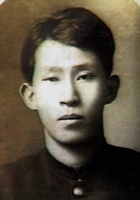Yi Sang
Yi Sang Poems
Up above the shimmering sea
Two or three seagulls are hovering.
Rolling, wheeling, they write a poem.
...
The first line is a full skirt,
the second is the bodice;
On reaching the third and last
...
the porcelain cup is similar to my skull. when i grasp the cup firmly with my hand an arm out of nowhere sprouts on my arm like a graft and the hand on
...
Yi Sang Biography
Yi Sang (September 14, 1910 – April 17, 1937) is an author of modern Korean literature. Though most widely known by his pen name, Yi Sang was born in Seoul, Korea, as Kim Hae-gyeong on September 14, 1910, in Seoul. He graduated from Sinmyeong School and then entered the Donggwang School. In 1922 he was admitted to Boseong Normal School. In 1929 he graduated from Gyeongseong Engineering High School with training as an architect and for a time was employed as a draftsman in the public works department of the Governor-General of Korea. In December 1929 he won first and third prizes in a design contest for the cover of Korea and Architecture (Joseongwa geonchuk), and the journal of the Korean Architecture Society (Joseon geonchukhoe), respectively. Most of his works were produced during the 1930s. In 1934 he joined the Circle of Nine (Guinhoe), whose core members included Kim Girim, Lee Taejun, and Jung Jiyong. In 1936 Lee began to edit the Circle of Nine[3] (GuInhoe, whose core members included Kim Girim, Lee Taejun, and Jung Jiyong) journal, Siwa soseol, published by Changmunsa under the aegis of Koo Bonung. Several of his works were published in this journal, including his poems “Paper gravestone” (Jibi), “Street exterior, street passage” (Gaoe gajeon), and “Condition serious” (Widok) and the stories “Meeting of a spider and a pig” (Jijuhoesi), “Wings” (Nalgae), “Meetings and Farewells” (Bongbyeolgi), and “Children's Skulls” (Donghae). His short story “Diary Before Death” (Jongsaenggi) and his personal memoir “Monotony” (Gwontae) were published posthumously in Tokyo. In November 1936 he went to Japan, where he was arrested by Japanese police the following year. He was released on bail and admitted to Tokyo University Hospital, where he died on April 17, 1937. Yi was perhaps the most famous avant-garde writer of the colonial era. In his work he experimented with language, interiority, separation from inside one's self as well as the outer world. His poems, particularly, were influenced by Western literary concepts including Dadaism and Surrealism. Yi's history in architecture influenced his work, which often included the languages of mathematics and architecture including, lines, dots, number systems, equations and diagrams. His literary legacy is punctuated by his modernist tendencies evinced throughout his oeuvre. His poems reveal the desolate internal landscape of modern humanity and, as in “Crow's eye view poem” (Ogamdo si je1ho), utilize an anti-realist technique to condense the themes of anxiety and fear. His stories disjoint the form of traditional fiction to show the conditions of the lives of modern people. “Wings” (Nalgae), for example, utilizes a stream-of-consciousness technique to express these conditions in terms of the alienation of modern people, who are fragmented commodities unable to relate to quotidian (daily) realities. Yi Sang never received much recognition for his writing during his lifetime, but his works began to be reprinted in the 1950s. In the 1970s his reputation soared, and in 1977 the Yi Sang Literary Award was established. His most famous short story is probably "The Wings" ("Nalgae", Hangul: 날개), and his poem "Crow's-Eye View" is also well-known.)
The Best Poem Of Yi Sang
I Will Write a Poem Too
Up above the shimmering sea
Two or three seagulls are hovering.
Rolling, wheeling, they write a poem.
I do not know the alphabet they use.
On the broad expanse of sky
I will write a poem too.
